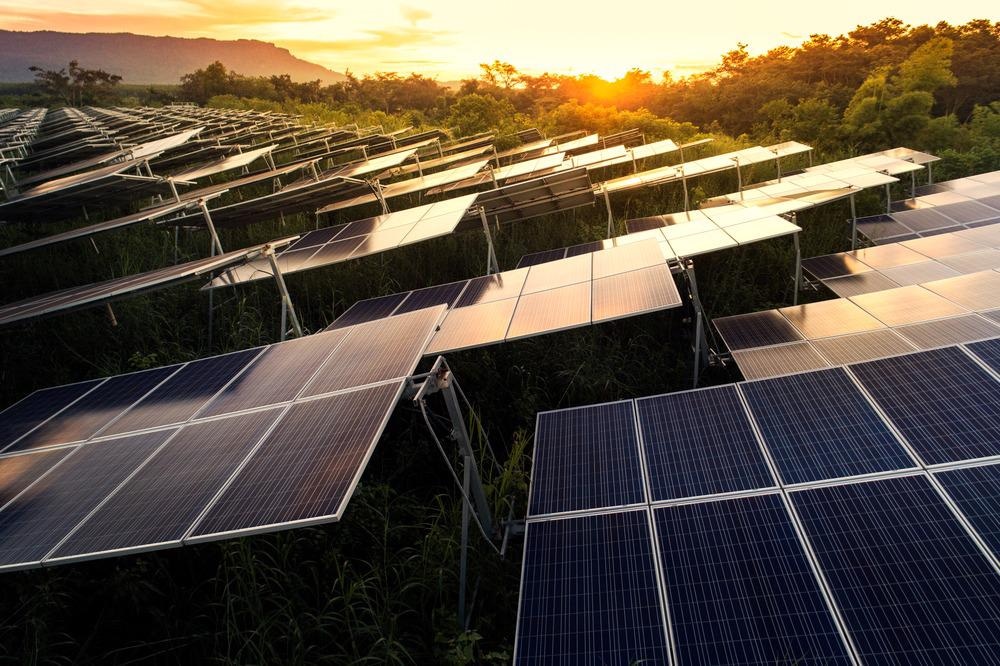 By Surbhi JainReviewed by Susha Cheriyedath, M.Sc.Mar 24 2022
By Surbhi JainReviewed by Susha Cheriyedath, M.Sc.Mar 24 2022In an article recently published in the journal ACS Applied Energy Materials, researchers discussed the utility of gadolinium fluoride (GdF3) as an electron-selective contact material for the development of solar cells with a high thickness tolerance.

Study: Gadolinium Fluoride as a High-Thickness-Tolerant Electron-Selective Contact Material for Solar Cells. Image Credit: Thongsuk7824/Shutterstock.com
Background
Solar cells made of crystalline silicon (c-Si) account for the vast bulk of the market. Due to their higher efficiency and low mass production, the photovoltaic industry has progressed from aluminum back-surface-field (Al-BSF) c-Si solar cells to rear cells and passivated emitters.
Traditional c-Si solar cells have low efficiency due to substantial recombination loss in Al-BSF3 and a high-temperature diffused p-n junction. A significant aspect in achieving c-Si solar cells with high efficiency is strong carrier selectivity. Thin heavily/intrinsic doped and hydrogenated amorphous silicon (a-Si/H) layers and ultrathin heavily doped/tunnel oxide poly-Si layers have a band-gap (Eg) wider than c-Si, demonstrating excellent carrier selectivity and efficiency.
The short-circuit current density (Jsc) will drop if the film thickness is not precisely controlled. The doping of these thin films also necessitates a high level of expertise and expensive equipment. Because of all these issues, mass production of such heterojunction solar cells is prohibitively expensive.
Due to its advantages of simplifying the preparation process and lowering intrinsic loss, a dopant-free carrier-selective contact (DFCSC) has been incorporated into the manufacturing of c-Si solar cells in recent years. Transition-metal oxides, including as NiOx, V2Ox, WOx, and MoOx have been extensively studied as dopant-free hole selective materials.
About the Study
In this study, the authors presented the development of GdF3 having a low work function, which was used to produce a low contact resistivity (ρc) Ohmic contact with lightly doped n-type c-Si (n-Si). The dopant-less GdF3/Al electron-selective contact is applied to n-Si solar cells with partial rear contact designs, and the corresponding power conversion efficiency (PCE) was estimated.
The researchers used GdF3 as a new dopant-free electron-selective contact material. Thermal evaporation was used to deposit GdF3 and Al films from powder and wire, respectively, under a high background vacuum. A crystal oscillator was used to monitor the GdF3 and Al deposition process, and ex situ spectroscopic ellipsometry was used to calibrate the thickness of GdF3 layers. Czochralski (Cz) n-Si wafers with sufficient resistivity were employed as substrates. For good sample conductivity, 5 nm GdF3 was coated on low-resistivity (0.05-0.1 Ωcm) polished silicon wafers for photoelectron spectroscopy characterization.
The team utilized X-ray photoelectron spectroscopy (XPS) to determine the composition and chemical state of the thin film formed on n-Si by thermal evaporation from GdF3 powder (99.99%). The transfer length method (TLM) was used to determine the contact resistivity of the n-Si (1-3 Ωcm)/GdF3/Al structure.
Observations
The low c for the GdF3/Al stack was replicated and showed good stability in an ambient atmosphere over a wide thickness variation (1.4-5.6 nm). The contact resistivity average and maximum values in this region were roughly 10 mΩ cm2 and less than 45 mΩ cm2, respectively.
Even after 1000 hours of exposure in air, the average contact resistivity values for samples with GdF3 layers between 1.4 and 5.6 nm were still less than 75 mΩ cm2. Furthermore, the interface picture and elemental distribution revealed Al diffusion into the GdF3 layer, which was attributed to its high thickness tolerance. The dopant-less GdF3/Al electron-selective contact applied to n-Si solar cells with partial rear contact designs obtained a high PCE of 20.71%, which revealed its enormous potential for mass production of optical and electrical devices.
More from AZoM: What is Femtosecond Laser-Based 3D Printing?
The XPS data revealed that the GdF3 film formed by thermal evaporation was stoichiometric. According to the ultraviolet photoelectron spectroscopy (UPS) measurements, the thin film material had an ultralow work function (ϕ = 2.85 eV). The results of high-resolution transmission electron microscopy (HRTEM) demonstrated that Al was diffused into the GdF3 layer and subsequently formed a mixing layer. The dispersed Al facilitated the electron transportation and explained the structure's high thickness tolerance. Proof-of-concept cells with a partial back contact architecture attained a PCE of 20.71%. However, cells with GdF3 thicknesses ranging from 1.4 to 5.6 nm had a PCE of around 20%.
F-1s of metal fluorides were found responsible for the peak at a binding energy of 685.19 eV. Gd 3d5/2 and F-1s had a relative sensitivity factor of 1:3.02. The thin film's valence band maximum was 5.3 eV lower than the Fermi level. After the GdF3 layer was inserted, the fill factor (FF) increased from 68.8 to 77.5%, and the open-circuit voltage (Voc) climbed from 621 to 652 mV. As a result, the cell's PCE improved from 17.40 to 20.71%.
Conclusions
In conclusion, this study elucidated that in a reasonably wide thickness range of 1.4 to 5.6 nm, the low contact resistivity, ρc (<2 mΩ cm2) of the GdF3/Al structure showed a mild thickness dependence. Diffusion and the mixing of Al were found responsible for the relatively high thickness tolerance of contact resistivity. A PCE of 20.71% was observed for the proof-of-concept solar cell.
The authors emphasized that GdF3 can be a promising dopant-free electron-selective contact material for low-cost and efficient solar cells. They also indicated that the impact of metal deposition rates and the possibility of an Al-GdF3 reaction will be investigated further.
Disclaimer: The views expressed here are those of the author expressed in their private capacity and do not necessarily represent the views of AZoM.com Limited T/A AZoNetwork the owner and operator of this website. This disclaimer forms part of the Terms and conditions of use of this website.
Source:
Chen, N., Cai, L., Xie, F., et al. Gadolinium Fluoride as a High-Thickness-Tolerant Electron-Selective Contact Material for Solar Cells. ACS Applied Energy Materials (2022). https://pubs.acs.org/doi/10.1021/acsaem.1c03919